Most African violets can be successfully propagated from leaf cuttings to vegetatively reproduce plants that will be identical to the plant from which the leaf cutting was taken. This is because the genetic make-up of any cell in the leaf cutting is the same as any other cell. This is not true with “chimeras”. These are plants that have developed plant tissues where the individual cells are genetically different. Because of this, plants produced from leaf cuttings frequently are not identical to the plant from which the cutting was taken
Though a chimera is any plant having this genetic characteristic, in African violets, this term is typically used to describe the “pinwheel” blossomed varieties, which frequently don’t propagate “true” to description from leaf cuttings. Examples of these can be seen in our catalog (go to the “African violets” section via the links in this web-site).
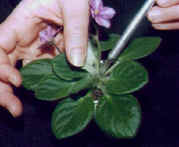
Step 1: Remove crown from plant center. Using a sharp knife or razor, carefully cut away the crown. If this is done carefully, this crown can be re-rooted (see step #5). Leave a few leaves on the plant that remains.
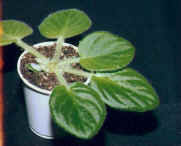
Step 2: The violet with center removed. Basically, just a “stump” with a few leaves attached. Continue to care for this as you would your other violets. If a bloom stalk should happen to appear, it can be removed.
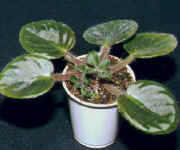
Step 3: Suckers appear from the decrowned plant. In time, perhaps 2-3 months, you should see little plantlets growing atop and around the “stump” that was left after decrowning. These “suckers”, when large enough, will then be removed to produce new plants.
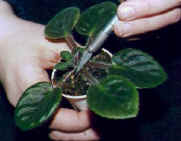
Step 4: Remove sucker from stump. Using a sharp knife or razor, carefully remove any sucker that appears big enough for you to comfortably handle. After removing these, you need not discard the “stump”–it may produce more suckers that can be “harvested” later. Suckers growing from the stump are more likely to produce plants identical to original plant than are those growing from beneath leaves or soil.
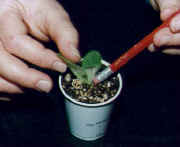
Step 5: Root the sucker. Fill a small pot with your normal soil mix (or your rooting mix, but this will necessitate a subsequent potting into your regular mix). Moisten the soil (again, moist but not soggy), and make a small “divot” or hole in the surface with a pencil tip (our favorite tool). Then, push the sucker into this small hole and firm-in soil around its base. Place the potted sucker into a clear, covered container or plastic “baggie” (e.g. a sandwich bag), and set aside in a bright place in moderate temperature. Don’t put in an overly warm place, or into bright or hot sunlight, since this may cause sucker to rot. In 3-4 weeks, the sucker should be rooted, and can be removed from its protective container.
Though not all suckers will produce blooms identical to the original plant, most of them will. As insurance, be sure that you’ve rooted the original crown that you removed from the plant in step #1, since this will continue to bloom true to variety.
Keep in mind that any violet can be propagated in this manner, but because it is more time consuming and produced fewer plantlets (that’s why chimeras cost more), there’s little reason to do so for nonchimeral varieties that will reproduce true from leaf cuttings.
10 COMMENTS
- JennyJanuary 28, 2021 9:43 pmMy precious 37 year old violet got rot in it when I was away. I’ve cleaned it up and repotted the neck and some viable roots. Two little, tiny leaves have appeared on the neck. I’m hoping I can grow a new plant from these suckers. Should I put it in a bag and blow in the bag to encourage growth? What should I do, I’m desperate to save it. ThanksReply
- Violet BarnJanuary 29, 2021 3:51 pmThose tiny leaves are the beginnings of a sucker. Normally, you’d want to remove these (any sucker–only keeping growing point in crown). In this case, though, since you’re trying to save this plant, you can let them grow. When they are large enough for you to comfortably handle, you can carefully remove the sucker (in one piece), and root it much like you are rerooting the plant now. Place the entire plant in a bag–soil should be moist, not soggy (so it doesn’t rot). It should root in 4-6 weeks.
- Norma KunzelSeptember 20, 2020 1:40 pmI have pots that have had plants in them found guilty of having mealy bugs. Is there any way to clean these pots and saucer for reuse.
Thanks.Reply - BrendaFebruary 27, 2020 8:31 pmAfter the crown has been rooted for 30 days and the plastic bag is removed, do you water it with plain water or diluted fertilizer? I want to feed it, but don’t want to hurt it.Reply
- Violet BarnMarch 6, 2020 2:13 pmYou may water it normally with fertilizer.
- celloNovember 28, 2019 11:07 amare babies from propaganting will be diffrent from their mother? and when u propagante 1 leaf u will get several babies right? are all the babies will be the diffrent each other too? (flowers)Reply
- Violet BarnNovember 29, 2019 7:13 pmChimeras can be propagated by leaf, but the plantlets produced likely will not have the same flower (or leaf) coloring as the plant you selected the leaf from.
- Elvie BlakelyJune 4, 2019 6:23 pmHeard in one of the presentations at 2019 AVSA that hot water will take care of the soil mealies. Don’t have them so I haven’t tried it.
Sorry that you are having problems.Reply - Debra EganJanuary 28, 2019 9:42 pmI have a mealy bug problem,in my 15 year collection. I have no idea where they came from. I am,thinking of spraying with an insecticide containing imidacloprid and starting over with crowns in baggies. I have already tried alcohol and natural stays and detergents. Any suggestions would be greatly appreciated. I inherited my love of violets from my grandmother and have some of her plants.Reply
- Violet BarnFebruary 2, 2019 10:05 amIt’s likely that spraying won’t be very effective for mealies. Crowns in baggies is a better idea–wash crowns as best you can and reroot in fresh soil. Unbag in 4-6 weeks and keep an eye out for a reinfestation. If none, you should be OK.
